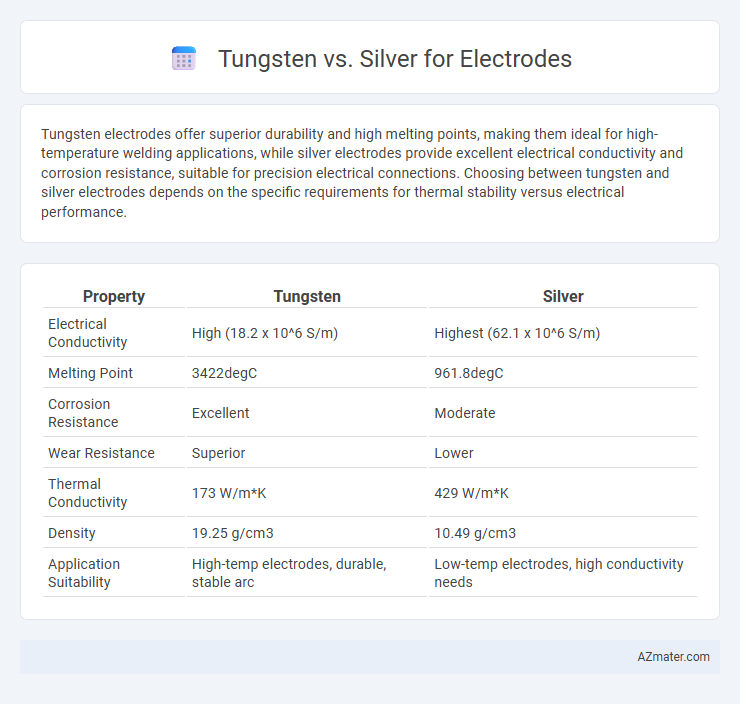Tungsten electrodes offer superior durability and high melting points, making them ideal for high-temperature welding applications, while silver electrodes provide excellent electrical conductivity and corrosion resistance, suitable for precision electrical connections. Choosing between tungsten and silver electrodes depends on the specific requirements for thermal stability versus electrical performance.
Table of Comparison
| Property | Tungsten | Silver |
|---|---|---|
| Electrical Conductivity | High (18.2 x 10^6 S/m) | Highest (62.1 x 10^6 S/m) |
| Melting Point | 3422degC | 961.8degC |
| Corrosion Resistance | Excellent | Moderate |
| Wear Resistance | Superior | Lower |
| Thermal Conductivity | 173 W/m*K | 429 W/m*K |
| Density | 19.25 g/cm3 | 10.49 g/cm3 |
| Application Suitability | High-temp electrodes, durable, stable arc | Low-temp electrodes, high conductivity needs |
Introduction to Electrode Materials: Tungsten vs Silver
Tungsten electrodes offer exceptional thermal stability and high melting points of 3422degC, making them ideal for high-temperature applications and resistance to oxidation. Silver electrodes provide superior electrical conductivity, approximately 6.3 x 10^7 S/m, supporting efficient current flow in low-resistance circuits but exhibit lower melting points around 962degC. Material choice between tungsten and silver electrodes depends on operational temperature requirements and conductivity priorities within electronic and welding applications.
Electrical Conductivity Comparison
Silver exhibits superior electrical conductivity at approximately 63 x 10^6 S/m, making it the most conductive metal widely used for electrode applications. Tungsten's electrical conductivity is significantly lower, around 18 x 10^6 S/m, which limits its efficiency in conducting electric current compared to silver. Despite tungsten's lower conductivity, its high melting point and durability make it suitable for electrodes in high-temperature environments where silver may degrade.
Mechanical Strength and Durability
Tungsten electrodes exhibit superior mechanical strength and durability due to their high melting point (3422degC) and excellent resistance to wear and deformation under high current loads. Silver electrodes, while offering excellent electrical conductivity, have lower mechanical strength and are more prone to deformation and wear during prolonged use. The durability of tungsten makes it the preferred choice for industrial applications requiring consistent performance under extreme conditions.
Corrosion Resistance and Stability
Tungsten electrodes exhibit superior corrosion resistance and stability compared to silver, especially in harsh chemical environments and high-temperature applications, due to tungsten's high melting point and inert oxide layer formation. Silver electrodes, while offering excellent electrical conductivity, are more prone to corrosion and surface degradation over time, particularly in acidic or sulfur-containing environments. The enhanced durability of tungsten ensures longer electrode lifespan and consistent performance in industrial electrochemical systems.
Thermal Conductivity in Electrodes
Tungsten exhibits a thermal conductivity of approximately 173 W/m*K, making it highly effective in dissipating heat in electrode applications where high melting point and durability are critical. Silver, with a superior thermal conductivity of around 429 W/m*K, provides excellent heat transfer capabilities but suffers from lower melting point and softer mechanical properties compared to tungsten. The choice between tungsten and silver electrodes depends on balancing thermal conductivity needs with material strength and temperature tolerance in high-performance electrical systems.
Cost and Availability of Tungsten and Silver
Tungsten electrodes are more cost-effective and widely available compared to silver, making them a preferred choice in applications requiring durability and affordability. Silver, though offering superior conductivity, is significantly more expensive and less abundant, limiting its use primarily to specialized, high-performance tasks. The scarcity of silver drives its cost higher, whereas tungsten's abundant supply ensures stable pricing and accessibility for industrial use.
Applications in Industry and Research
Tungsten electrodes excel in high-temperature and high-current industrial applications such as welding, plasma cutting, and electrical discharge machining due to their exceptional thermal conductivity and oxidation resistance. Silver electrodes are favored in precision research settings and electronics manufacturing for their superior electrical conductivity and low contact resistance, enabling enhanced signal integrity and sensitivity. Both materials serve critical roles in electrochemical processes, with tungsten often preferred for durability under harsh conditions and silver valued for catalytic efficiency and antibacterial properties.
Compatibility with Different Environments
Tungsten electrodes exhibit exceptional resistance to high temperatures and corrosion, making them highly compatible with harsh industrial environments and applications involving reactive gases. Silver electrodes offer superior electrical conductivity but can tarnish easily in oxidizing environments, reducing their effectiveness in high-humidity or corrosive atmospheres. Choosing between tungsten and silver electrodes depends on the specific environmental conditions, with tungsten preferred for durability and stability and silver for maximum conductivity in cleaner, controlled settings.
Longevity and Maintenance Requirements
Tungsten electrodes offer superior longevity due to their high melting point and excellent resistance to wear, making them ideal for extended welding applications. Silver electrodes, while providing higher electrical conductivity, tend to wear faster and require more frequent maintenance to maintain optimal performance. Choosing tungsten reduces downtime and maintenance costs, ensuring longer-lasting electrode efficiency in industrial settings.
Choosing the Right Electrode Material: Key Considerations
Tungsten electrodes offer exceptional high-temperature stability and superior resistance to wear and oxidation, making them ideal for applications requiring durability and longevity. Silver electrodes excel in electrical conductivity and thermal management, suitable for environments demanding efficient current flow and heat dissipation. Selecting the right electrode material depends on factors like operating temperature, electrical conductivity requirements, mechanical strength, and specific application conditions to ensure optimal performance and cost-effectiveness.

Infographic: Tungsten vs Silver for Electrode
 azmater.com
azmater.com